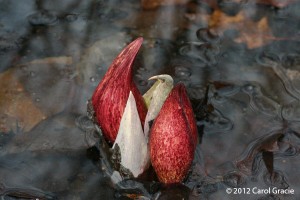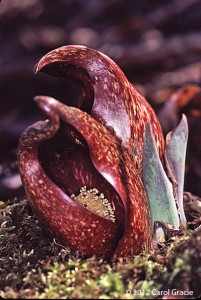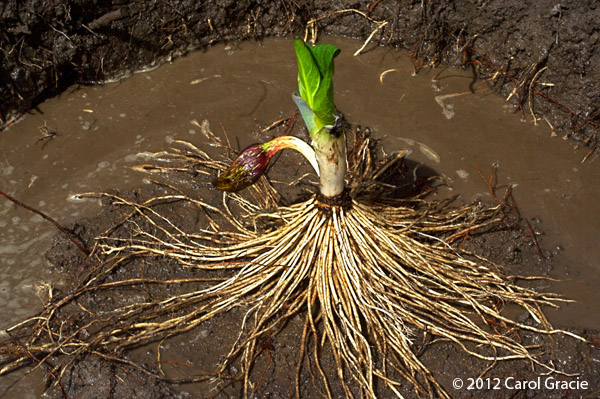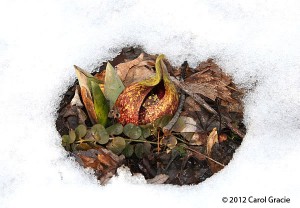Weekly Wildflower: The First Wildflower of Spring–Or the Last of Winter?
Posted in Around the Garden, What's Beautiful Now on March 29 2013, by Carol Gracie
After spending nearly three decades at NYBG, and working much of that time in South American rainforests with her husband, Scott A. Mori, Carol Gracie has returned to one of her first botanical interests in retirement–local wildflowers. She is the author of Spring Wildflowers of the Northeast: A Natural History and coauthor (with Steve Clemants) of Wildflowers in the Field and Forest: A Field Guide to the Northeastern United States.

For those thirsting for some sign of rebirth after a long, cold winter, you need go no further than the closest swamp. Skunk cabbage (Symplocarpus foetidus) has been up and in flower for over a month now. In fact, skunk cabbage may be found in flower as early as mid-February in this area. While many people may not consider skunk cabbage to be a ”true” spring wildflower, that is, one that is sweet, delicate, and pastel-colored, it is, indeed, one of our native wildflowers, and a plant deserving of our attention and admiration. The floral parts have a certain sculptural beauty, and the deep maroon color is striking in the otherwise bleak landscape.

Skunk cabbage gets a bad rap from its association with the unpleasant odor of skunk. However, the plant only emits this foul aroma if the cells of its leaves and other parts are crushed when broken or bruised. No odor is discerned if one merely walks by an undisturbed patch of skunk cabbage.
Skunk cabbage is a member of the Araceae, or Jack-in-the-pulpit plant family–a family easily recognized, and widely planted in the Azalea Garden, by the arrangement of its inflorescence (the grouping of floral parts). Each inflorescence is comprised of a ball-like or elongate spadix, which bears the actual flowers, and a modified leaf-like structure (the spathe) that surrounds it; Jack-in-the-pulpit is a good example of this characteristic form and will be the topic of a future wildflower post.
It is skunk cabbage’s adaptation to life in a difficult habitat (generally swamps) and to a harsh time of year (late winter to early spring) that is truly remarkable. To maintain its hold in spongy, wet soil, skunk cabbage has evolved a massive system of long, tenacious roots that anchor the plant in place even during times of flooding. They also pull the plant more firmly into the ground as a result of a series of expansions and contractions of each root.

In order to survive–and even flower–during the cold temperatures of February and March, the skunk cabbage’s spadix is capable of generating heat through the process of respiration.

It can maintain a temperature of 68° F even when the temperature of the ambient air falls below freezing. The surrounding hood-like structure, or spathe, of the skunk cabbage inflorescence is thick and spongy, much like Styrofoam, and serves as an insulating enclosure to maintain a warm temperature inside of the inflorescence. This warmth, in addition to the dark coloration of the spathe, which absorbs solar radiation, promotes melting of the snow that surrounds the plant.
I delve far more deeply into the mysteries of the skunk cabbage in my book, Spring Wildflowers of the Northeast: A Natural History, available at Shop in the Garden. To see hundreds of beautiful and fascinating native plants, trees, and shrubs be sure to visit the new Native Plant Garden during Grand Opening Weekend, May 3-5, 2013.
If you would like to hear more from Carol, she will be speaking about spring wildflowers at the next meeting of the Torrey Botanical Society, which takes place in the Ross Lecture Hall at The New York Botanical Garden on Tuesday, April 2nd at 6:30 p.m. It’s free and open to the public; refreshments are served from 6:00.


I love these wildflower posts Carol!
If people want to see video of skunk cabbage, Dr. Chris Martine just explored this plant in his latest episode of Plants are Cool too: http://www.youtube.com/watch?v=iX7n24ZeqAw